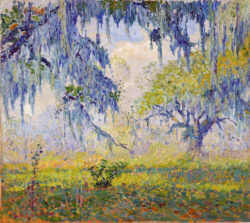Louis Oscar Griffith
Artist Louis O. Griffith was not a native of Louisiana, but he discovered its charms on a visit to New Orleans and proceeded to depict the city in his artwork.

Courtesy of Haynie Family Collection
City Park. Griffith, Louis O. (Artist)
Louis Oscar Griffith was not a native of Louisiana, but he discovered its charms on a visit to New Orleans and proceeded to depict the city in his artwork. Born in Greencastle, Indiana, on October 10, 1875, Griffith eventually made his home in Nashville, Indiana, and died in Franklin, Indiana, on November 13, 1956. For much of his adult life, he traveled the world. During his stay in New Orleans, he produced a series of prints depicting scenes from daily life in the city. Typical among them were images of banana boats being unloaded at the New Orleans dock and views of St. Louis Cathedral in the French Quarter. In addition to being a printmaker, Grafton was a painter of realistic landscapes and portraits and a highly skilled maker of etchings.
As a child Griffith is said to have drawn illustrations and cartoons on any available surface, but he did not begin painting until he enrolled in classes with Frank Reaugh, a well-known painter in Dallas, Texas, around 1890. At the time Griffith was working as a clerk in the checkroom at the Grand Windsor Hotel in Dallas, and for the next decade he painted in his off hours at Reaugh’s studio. In 1893 he left Dallas for Missouri, where he studied at the St. Louis School of Fine Arts. In 1895 Griffith moved to Chicago, Illinois, where he enrolled in evening classes at the Chicago Art Institute while he supported himself by day as a commercial artist. The art scene in that city energized his commitment to make a career as an artist. It was through membership in the Palette and Chisel Club, an organization of young artists that was partly professional and partly social, that he met the painter Robert W. Grafton, with whom he would sustain a friendship for years.
After a return to Texas and two painting expeditions through the American West with Reaugh, Griffith went on to explore the coast of Maine and took trips to France and England, in all likelihood to perfect his printmaking skills. In search of new subject matter, Griffith made a trip to New Orleans with Grafton in 1916. During their time there they explored the historic city and painted scenes characteristic of its daily life. The two men collaborated to produce two murals for the city’s St. Charles Hotel that received widespread praise. Griffith continued to make art in New Orleans into 1917, often exhibiting his work at the Art Association of New Orleans. Several prints that he produced during this period, including Street Gossip and Madame Begue’s, were exhibited at the gallery of the Highland Park Society of Arts at in Dallas. Grafton’s etching The Old Morphy House, also created during his stay in New Orleans, was included in the Second International Exhibition of Modern Engravings in Florence, Italy, in 1927.
Griffith was the recipient of many honors and awards, including the gold medal from the Palette and Chisel Club in 1921, first prize from the Texas Wildflower Competition in 1929, the John C. Shaffer Outstanding Picture Prize from the Hoosier Salon in 1930, a first-place blue ribbon of the Chicago Society of Etchers in 1949, and the 1953 Prize of the Chicago Society of Etchers. His work was shown widely, often in group exhibitions such as the Library of Congress National Exhibition of Prints and the National Academy of Design show in 1943, and at the National Gallery of Art in 1945.
